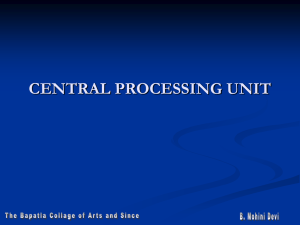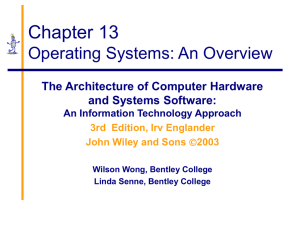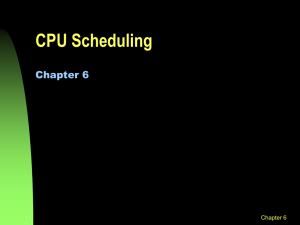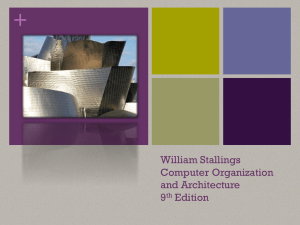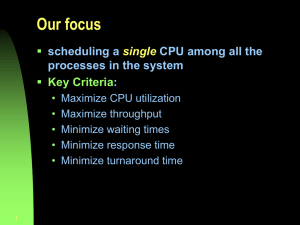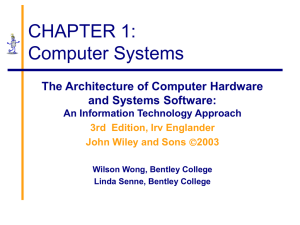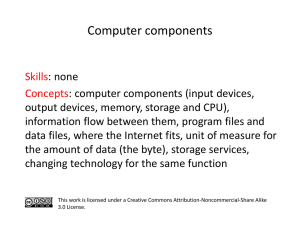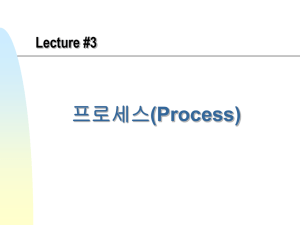os-lecture07
advertisement
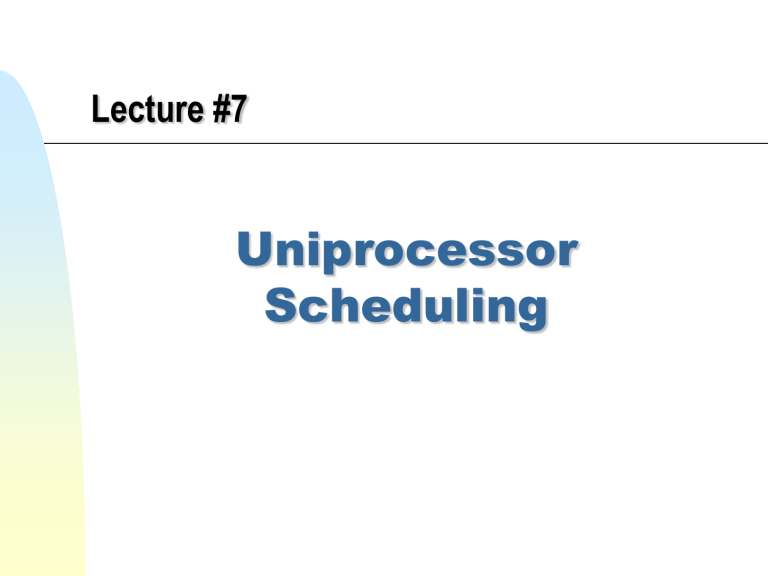
Lecture #7
Uniprocessor
Scheduling
CPU Scheduling
다중 프로그래밍 시스템에서 실행준비 상태인 프로세스
중에서 다음에 실행될 프로세스를 결정하여 CPU를
할당하는 동작
목 적:
High processor utilization
High throughput
Low response time
Operating System
number of processes completed per unit time
elapsed time from the submission of a request to the beginning of
the response
2
Operating System
3
스케줄링 동작의 분류
Long-term : which process to admit
Medium-term: which process to swap in or out
Short-term: which ready process to execute next
Operating System
4
Queuing Diagram for Scheduling
Operating System
5
Long-Term Scheduling
어떤 프로그램을 시스템에서 실행할 수 있도록 허용할
것인가를 결정하는 작업
다중 프로그래밍 정도(the degree of multi-programming)를
결정한다
많은 프로세스를 허용하는 경우:
모든 프로세스가 대기상태(blocked)가 될 가능성이 적어진다
각 프로세스에 대한 CPU 할당 시간이 적어진다
CPU 이용률을 높일 수 있다
각 프로세스의 반응 시간이 길어진다
Processor-bound 프로세스와 I/O-bound 프로세스를
적절하게 혼합될 수 있도록 허용하는 것이 효율적
Operating System
6
Medium-Term Scheduling
Swapping decisions based on the need to manage
multiprogramming
어떤 프로세스를 swapping 할 것인지를 결정
메모리 관리 소프트웨어에 의해 수행
Operating System
7
Short-Term Scheduling
어떤 프로세스를 다음에 실행할 것인지를 결정
CPU scheduling
Dispatcher
준비 상태의 프로세스 중에서 다음에 실행할 프로세스를 선택
선택된 프로세스에게 CPU를 할당
문맥을 교환
사용자 모드로 전환
프로그램 실행을 위해 사용자 프로그램의 적절한 위치로 이동 –
PC(program count) 설정
CPU 스케줄링이 수행되는 시점(events):
Operating System
clock interrupts
I/O interrupts
operating system calls and traps
signals
8
CPU-I/O Burst Cycle
하나의 프로세스는 CPU 작업과
I/O 작업을 교대로 요구하는
동작을 반복적으로 수행
Operating System
각 사이클은 CPU burst (typically
of 5 ms)와 I/O burst(usually
longer)로 구성
프로세스는 CPU burst로 시작하여
CPU burst로 종료
CPU-bound process는 I/Obound process보다 더 긴 CPU
bursts을 갖는다
load store
add store
read from file
Wait for I/O
store increment index
write to file
CPU
Burst
I/O
Burst
CPU
Burst
Wait for I/O
I/O
Burst
load store
add store
read from file
CPU
Burst
Wait for I/O
I/O
Burst
9
CPU 스케줄링 기준(Criteria)
사용자 관점 기준
Response Time(응답 시간): 프로그램이 제출된 때부터 반응을
시작하는데 걸리는 시간
Turnaround Time(작업 반환 시간): 프로그램이 제출된 때부터
완료될 까지 걸리는 시간
시스템 관점 기준
Operating System
processor utilization(CPU 이용률)
Fairness(공평성)
Throughput(처리율): 단위 시간당 수행 완료하는 프로세스 수
10
Operating System
11
Operating System
12
CPU 스케줄링 알고리즘의 특성
선택함수(selection function)
ready queue에 있는 프로세스들 중에서 다음에 실행한 프로세스를
결정하는 방법(기준)
결정모드(decision mode)
선택함수를 실행할 시점을 정의
Non-preemptive(비선점)
Preemptive(선점)
Operating System
일단 프로세스가 실행상태가 되면 실행을 종료하거나 I/O로 인해
대기상태가 될 때까지 실행을 계속하는 모드
현재 실행중인 프로세스를 중지하여 ready queue에 보내고 새로 선택된
프로세스를 실행하는 모드
하나의 프로세스가 오랜 시간동안 CPU를 독점하지 못하도록 함으로써 더
나은 서비스를 허용한다
13
CPU 스케줄링 알고리즘
선입 선처리(First Come First Served) 스케줄링
라운드 로빈(Round-Robin) 스케줄링
짧은 프로세스 우선(Shortest Process Next:SPN) 스케줄링
최단 잔여 시간(Shortest Remaining Time:SRT) 스케줄링
최고 응답률 우선(Highest Response Ratio Next:HRRN) 스케줄링
우선순위(Priority) 스케줄링
다단계 피드백 큐(Multi-level Feedback Queue) 스케줄링
Multiprocessor 스케줄링
실시간 스케줄링(Real-Time Scheduling)
Operating System
14
CPU 스케줄링 알고리즘의 비교
Process
Arrival
Time
Service
Time
1
0
3
2
2
6
3
4
4
4
6
5
5
8
2
- Service time = total processor time needed in one (CPU-I/O) cycle
- Jobs with long service time are CPU-bound jobs and are referred
to as “long jobs”
Operating System
15
선입 선처리 스케줄링 :
First Come First Served (FCFS)
선택함수
ready queue 에서 가장 오랫동안 대기하고 있는 프로세스를 선택
First Come First Served(FCFS)
결정모드
Operating System
Non-preemptive(비선점)
프로세스는 종료하거나 대기상태가 될 때까지 실행한다
16
FCFS 스케줄링의 단점
어떤 I/O도 요구하지 않는 프로세스가 CPU를 독점할 수 있다
CPU-bound process를 선호한다
I/O-bound process는 CPU-bound process가 종료할 때까지
기다려야 한다
I/O-bound process는 I/O가 완료되더라도 기다리는 상태이므로 다음
I/O을 실행하지 못한다(poor device utilization)
I/O bound process에 한 레벨 높은 우선순위를 부여함으로써 I/O
device의 이용률을 높일 수 있다
Operating System
17
라운드-로빈(Round-Robin) 스케줄링
선택함수: FCFS와 같다
결정모드: preemptive(선점)
Operating System
프로세스는 하나의 time slice (quantum, typically from 10 to 100
ms) 동안에 실행된다
clock interrupt가 발생하면 현재 실행중인 프로세스를 ready
queue로 보내고 FCFS 방식으로 새로운 프로세스를 실행한다
18
Time Quantum for Round Robin (1)
Clock interrupt과 dispatching 처리를 위한 시간보다 더
크게 결정되어야 한다
should be larger than the typical interaction
Operating System
작업 반환 시간이 커질 수 있다
19
Time Quantum for Round Robin (2)
Operating System
20
Round Robin 스케줄링 분석
여전히 CPU-bound process를 선호한다
I/O bound process는 time slice보다 적은 시간동안 CPU를
사용하고 I/O 요구에 대해 대기상태가 된다
CPU-bound process는 모든 time slice 동안 실행되고 ready
queue로 되돌아간다. 이때, 대기 상태의 프로세스 앞에 놓이게
된다
해결책: 가상 라운드 로빈(virtual round robin)
Operating System
I/O가 완료되었을 때에 대기 상태의 프로세스를 ready queue보다
높은 우선순위를 가지는 보조 큐(auxiliary queue)에 보낸다
21
Queuing for Virtual Round Robin
Operating System
22
Shortest Process Next (SPN) 스케줄링
선택함수:
가장 짧은 CPU burst time을 가진 프로세스를 선택한다
최소 작업 우선(Shortest Job First) 스케줄링
결정모드: non-preemptive(비선점)
I/O bound process가 먼저 선택된다
각 프로세스의 CPU burst time을 미리 예측하여야 한다
Operating System
23
CPU burst time 예측(1)
Let T[i] be the execution time for the i-th instance of
the process
Let S[i] be the predicted value for the i-th CPU burst of
this process. The simplest choice is:
S[n+1] = (1/n) S_{i=1 to n} T[i]
To avoid recalculating the entire sum we can rewrite
this as:
the actual duration of the i-th CPU burst of this process
S[n+1] = (1/n) T[n] + ((n-1)/n) S[n]
But this convex combination gives equal weight to
each instance
Operating System
24
CPU burst time 예측(2)
But recent instances are more likely to reflect future
behavior
A common technique for that is to use exponential
averaging
Operating System
S[n+1] = a T[n] + (1-a) S[n] ; 0 < a < 1
more weight is put on recent instances whenever a > 1/n
25
SPN 스케줄링 분석
짧은 프로세스가 계속적으로 생성될 때에는 긴 프로세스가
starvation 될 가능성이 있다
비선점 방식이므로 시분할 환경(대화형 환경)에는
부적합하다
CPU bound process가 낮은 우선순위를 가지지만 여전히 I/O을
요구하지 않는 프로세스가 CPU를 독점할 수 있다
대화형 응용 프로그램 실행에는 부적합
SPN 스케줄링은 함축적으로 우선순위 기법을 수용한다
Operating System
shortest jobs are given preferences
26
Shortest Remaining Time (SRT) 스케줄링
선택함수:
예측된 잔여 처리 시간이 가장 짧은 프로세스를 선택
SPN 스케줄링의 선점형
결정모드: preemptive(선점)
Operating System
새로운 프로세스의 처리 요구 시간이 현재 수행중인 프로세스의 잔여
처리 시간보다 짧은 경우 선점된다
27
Shortest Remaining Time (SRT) 스케줄링
분 석:
FCFS 스케줄링보다는 공평한 스케줄링을 수행
Operating System
실행 시간이 긴 프로세스들이 기아 상태에 빠질 가능성이 존재
라운드-로빈과 달리 인터럽트가 추가로 발생하지 않음
선점형이기 때문에 SPN보다 작업처리 시간이 훨씬 짧다
프로세스의 처리 시간 예측 및 프로세스 서비스 시간 계산에 대한
오버헤드가 존재
28
Highest Response Ratio Next (HRRN)
스케줄링
선택함수:
응답 비율(RR: Response Ratio)이 가장 큰 프로세스를 선택
RR = (CPU 대기 시간 + 예측된 서비스 시간)/예측된 서비스 시간
모든 프로세스들에 대한 응답 비율의 평균값을 최소화
결정모드: nonpreemptive(비선점)
Operating System
29
Highest Response Ratio Next (HRRN)
스케줄링
분 석:
Operating System
프로세스의 대기 시간을 고려하기 때문에 효과적
일반적으로 짧은 실행시간을 가진 프로세스가 유리
실행 시간이 긴 프로세스의 경우 대기 시간이 증가함에 따라
응답비율이 증가하여 짧은 실행 시간의 프로세스보다 먼저 실행
30
우선순위 스케줄링 :
Priority Scheduling
선택함수 : 우선 순위 기반의 스케줄링
결정모드: preemptive(선점)
각 우선순위 레벨을 나타내는 다수의 ready queue을
사용하여 구현할 수 있다
프로세스의 우선순위를 비교
높은 우선순위의 프로세스를 먼저, 같은 수준의 우선순위를 가진
프로세스에 대해서는 FCFS 방식으로 선택
Multi-level queue
낮은 우선순위 프로세스가 starvation 될 수 있다
동적 우선순위(dynamic priority) 사용
Operating System
실행 시간 경과에 따라 프로세스의 우선순위를 바꾼다
31
Operating System
32
다단계 피드백 큐 스케줄링 :
Multilevel Feedback Queue Scheduling
Preemptive scheduling with dynamic priorities
Several ready queues with decreasing priorities:
P(RQ0) > P(RQ1) > ... > P(RQn)
새로운 프로세스는 RQ0에 보낸다
Time slice가 완료되면 프로세스를 RQ1으로 보낸다. 그리고
그 다음 단계에서는 RQ2로, 계속하여 RQn까지 보내도록
한다
Operating System
33
다단계 피드백 큐 스케줄링 :
Multilevel Feedback Queue Scheduling
I/O-bound process는 높은 우선순위 큐에서 유지되는
반면에 CPU-bound process는 낮은 우선순위 큐로
옮겨간다
Dispatcher는 RQi-1에서 RQ0 까지의 큐가 비어있을 때에
RQi 에서 실행할 프로세스를 선택한다
긴 프로세스는 starvation 될 가능성이 있다
Operating System
낮은 우선순위 큐에서 오래 대기한 프로세스를 높은 우선순위 큐로
이동시킴(aging)으로써 해결
34
Multiple Feedback Queues
각 큐에서는 FCFS 스케줄링
가장 낮은 우선순위 큐에서는 Round-Robin 스케줄링
Operating System
35
Time Quantum for MFQ Scheduling
고정 크기의 time slice를 가지는 경우, 긴 프로세스의 작업 반환 시간이
대단히 길어질 수 있다
큐의 레벨에 따라 time slice를 증가시킴으로써 평균 작업 반환 시간을
줄일 수 있다
Operating System
예: time slice of RQi = 2^{i-1}
36
스케줄링 알고리즘의 특성 비교
Operating System
37
Operating System
38
Fair-Share Scheduling(FSS)
User’s application runs as a collection of processes
(threads)
User is concerned about the performance of the
application
Need to make scheduling decisions based on process
sets
Operating System
39
Operating System
40
Traditional UNIX Scheduling
유닉스 시스템 : 시분할 대화식 사용환경을 지원
CPU 스케줄링 알고리즘에 대한 요구사항:
대화형 사용자에게 좋은 응답시간을 제공
낮은 우선순위의 후위(background) 프로세스들이 기아 상태에
빠지지 않고 수행
Multilevel feedback using round robin within each of
the priority queues
If a running process does not block or complete within
1 second, it is preempted
Priorities are recomputed once per second
Base priority divides all processes into fixed bands of
priority levels
Operating System
41
Bands
Decreasing order of priority
Swapper
Block I/O device control
File manipulation
Character I/O device control
User processes
우선순위 큐를 계층적인 구조로 구성하는 이유는 입출력
징치를 효율적으로 사용할 수 있도록 하기 위함
Operating System
42
Bands of process priorities
Kernel and user priorities
Operating System
43
Operating System
44
